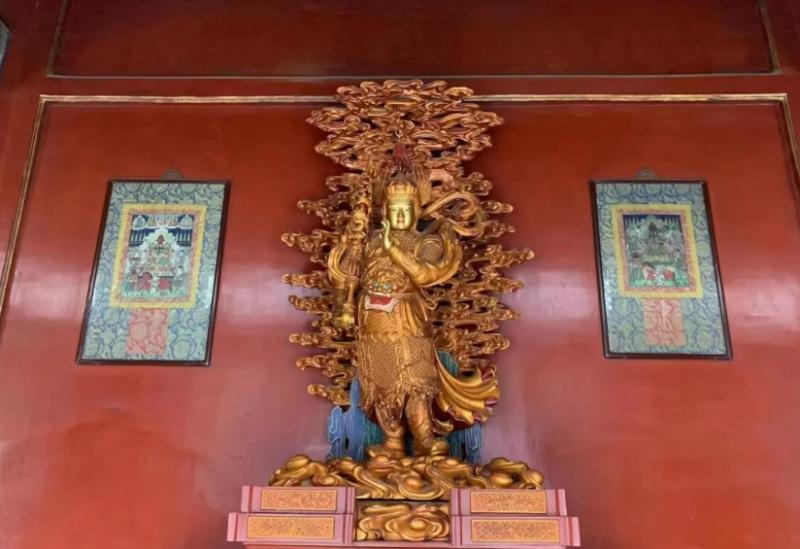The Longevity Buddha Pagodas in the Hall of Heavenly Kings at Yonghe Temple

Reference: Yonghe Temple: A Cultural Gem of Buddhism in Beijing
The Hall of Heavenly Kings at Yonghe Temple has its origins traced back to the ninth year of Emperor Qianlong's reign when the Yong Prince's Mansion was converted into the Lama Temple Yonghe Temple. The former gatehouse of the mansion was transformed into the temple's mountain gate, housing the Four Heavenly Kings inside, thus becoming known as the Hall of Heavenly Kings. Despite its role as the Hall of Heavenly Kings, it possesses distinct royal characteristics worth noting:
- Architectural Style: Firstly, the architectural style of the Hall of Heavenly Kings adheres to imperial standards, featuring five bays, three sections, and a hipped roof covered with yellow glazed tiles. The couplet inscribed on the walls reads, "The mirror of the Dharma reflects light, illuminating the day of wisdom; the purity of Muni Buddha brings forth auspicious clouds from the ten grounds." These couplets exude a sacred atmosphere within the hall.
- Artistic Depictions: Secondly, at the feet of the Four Heavenly Kings are pairs of monsters, known as the "Eight Legions of Heavenly Dragons," reflecting the style of Tibetan Buddhism, which differs slightly from that of Han Buddhism, where these monsters are usually omitted.
- Tibetan Influence: Thirdly, behind the hall, a bronze statue of Wei Tuo Bodhisattva is enshrined, while a pair of thangkas depicting the god Guan Yu hangs on the back screen, showcasing Tibetan-style artistry. This inclusion of the Han Buddhist deity Guan Yu into the Tibetan Buddhist pantheon illustrates the syncretism of religious beliefs.
- Longevity Buddha Pagodas: Lastly, inside the Hall of Heavenly Kings are a pair of Longevity Buddha Pagodas, the focal point of the hall. Originating from India, these pagodas were originally the tomb mounds of Buddhas and eminent monks. With the spread of Buddhism to China, they evolved into religious architectural structures, maintaining their fundamental function of enshrining the relics of high monks.
Indoor pagodas, as seen in the Hall of Heavenly Kings, represent the evolution of pagodas. They often house small Buddha statues, serving as Buddhist offerings to enhance the religious atmosphere and ward off evil spirits. However, the pair of nine-story wooden pagodas in Yonghe Temple, standing at 3.5 meters tall and crafted from rosewood, is a rare display of imperial extravagance.
These nine-story pagodas are adorned with "Tsatsa" - small Buddha figures affixed to the pagoda's surface, totaling 274 in number, with a majority dedicated to the Longevity Buddha, alongside a small portion depicting the White Tara. The Longevity Buddha, White Tara, and Victorious Buddha Mother form the "Three Longevity Deities." The Longevity Buddha's full name is "Holy Immeasurable Life, Intelligence, and Light King Tathagata."
"Tsatsa" is a unique religious art form of Tibetan Buddhism, crafted from special clay molds resembling shallow reliefs, which are then painted with colors. They can be displayed independently as offerings or used as decorative attachments in religious settings.
When touring the Hall of Heavenly Kings at Yonghe Temple, it is essential to appreciate these characteristics. Doing so not only enhances understanding of the temple's historical and cultural significance but also allows one to experience the beauty of its unique religious artistry.
QA:
-
What distinguishes the Hall of Heavenly Kings at Yonghe Temple from other structures?
The Hall of Heavenly Kings at Yonghe Temple is distinguished by its adherence to imperial architectural standards, its incorporation of Tibetan Buddhist artistry, and the presence of Longevity Buddha Pagodas.
-
Can you explain the significance of the "Tsatsa" figures found on the pagodas?
"Tsatsa" figures are unique to Tibetan Buddhism and serve as religious artifacts. Crafted from special clay molds and painted with colors, they represent offerings to enhance the religious atmosphere and ward off evil spirits.
note: This return of all, without the author's permission, may not be reproduced